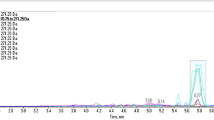Abstract
The recovery of heroin in fumes was investigated. In the Netherlands the common mode of heroin smoking is the ‘chasing the dragon’ procedure: heroin is heated on an aluminium foil by a lighter and the fumes are inhaled. The efficiency of the volatilization of heroin using this procedure was studied under laboratory conditions using thin layer chromatography, gas chromatography and high pressure liquid chromatography. A considerable influence of the form (salt or base) of the heroin was found as well as strong influences of other substances that may be present in illicit heroin samples as diluents. The danger of the inhalation of fumes containing unknown pyrolysis products is mentioned and a hypothesis is given for the phenomenon of ‘heroin’-leucoencephalopathy that was observed in heroin smokers in Amsterdam in 1981. The types of heroin encountered in the Netherlands are discussed with regard to their suitability for smoking.
Similar content being viewed by others
References
Anonymous. Les mystérieuses pilules d'heroine à fumer. Bull Stupef 1953;5(2):54–9.
Anonymous. Chasing the dragon. The smoking of heroin in Hong Kong. Bull Narc 1958;10(3):6–7.
Mari F, Bertol E, Tosti M. Heroin in the Florence area, Italy. Bull Narc 1982;34(1):37–44.
Van Vendeloo F, Franke JP, De Zeeuw RA. Fingerprint analysis of illicit heroin samples by gas chromatography. Pharm Weekbl [Sci] 1980;2:129–36.
Huizer H, Logtenberg H, Steenstra AJ. Heroin in The Netherlands. Bull Narc 1977;29(4):65–74.
Moore JM, Allen AC, Cooper DA. Determination of manufacturing impurities in heroin by capillary gas chromatography with electron capture detection after derivatization with heptafluorobutyric anhydride. Anal Chem 1984:56:642–6.
O'Neill PJ, Gough TA. Illicity imported heroin products: Some physical and chemical features indicative of their origin. Part 11. J Forensic Sci 1985;30:681–91.
Müller EM, Neumann H, Fritschi G, Halder T, Schneider E. Vergleichende gaschromatographische Untersuchungen von Heroinproben. Arch Kriminol 1984;173:29–35.
Huizer H, Jellema RJ. Internal yearly reports on drugs. Rijswijk/Amsterdam: Forensic Science Laboratory and Laboratory of the Municipal Police Amsterdam, the Netherlands, 1979–1986.
Ito R. Amount of effective component which passes into smoke when heroin is smoked. Jpn J Med Sci iv Pharmacol Trans 1936;9:177 (via Chemical Abstracts 1937;31:80225).
Netze JP. Volatility of opiates [Report]. Leiden: State University of Leiden, 1978.
Gruhzit CC. Pharmacological investigation and evaluation of the effects of combined barbiturate and heroin inhalation by addicts. Bull Narc 1958;10:8–11.
Mo BP, Way EL. An assessment of inhalation as a mode of administration of heroin by addicts. J Pharmacol Exp Ther 1966;154:142–51.
Cook CE, Brine DR. Pyrolysis products of heroin. J Forensic Sci 1985;30:251–61.
Anonymous. The Merck Index. 10th ed. Rahway: Merck & Co. Inc., 1983.
Anonymous. British Pharmacopoeia 1963. London: The Pharmaceutical Press, 1963.
Wolters ECh, Stam FC, Lousberg RJ, et al. Leucoencephalopathy after inhaling ‘heroin’ pyrolysate. Lancet 1982;2:1233–7.
Wolters ECh, Van Wyngaarden GK, Stam FC, et al. ‘Heroine’-leuko-encefalopathie; spongiforme leukomyelo-encefalopathie na inhalatie van het pyrolysaat van verontreinigde heroine. [‘Heroin’ leucoencephalopathy; spongiform leueo-myelo-encephalopathy after inhalation of the pyrolysate of contaminated heroin]. Ned Tijdschr Geneeskd 1982;126:508–14.
Clarke EGC. Isolation and identification of drugs. London: The Pharmaceutical Press, 1969.
Eskes D, Brown JK. Heroin-caffeine-strychnine mixtures. Where and why? Bull Narc 1975;27(1):67–9.
Previous papers in these series are:
Huizer H. Analytical studies on illicit heroin. 1. The occurrence ofO 3-Monoacetylmorphine. J Forensic Sci 1983;28:32–9.
Huizer H. Analytical studies on illicit heroin. 11. Comparison of samples. J Forensic Sci 1983;28:40–9.
Huizer H. Analytical studies on illicit heroin, 111. Autointerference in the colorimetric determination of strychnine in illicit heroin samples. Pharm Weekbl [Sci] 1983;5:254–5. (Part iv is in preparation).
Author information
Authors and Affiliations
Rights and permissions
About this article
Cite this article
Huizer, H. Analytical studies on illicit heroin. Pharmaceutisch Weekblad Scientific Edition 9, 203–211 (1987). https://doi.org/10.1007/BF02029331
Received:
Revised:
Accepted:
Issue Date:
DOI: https://doi.org/10.1007/BF02029331




